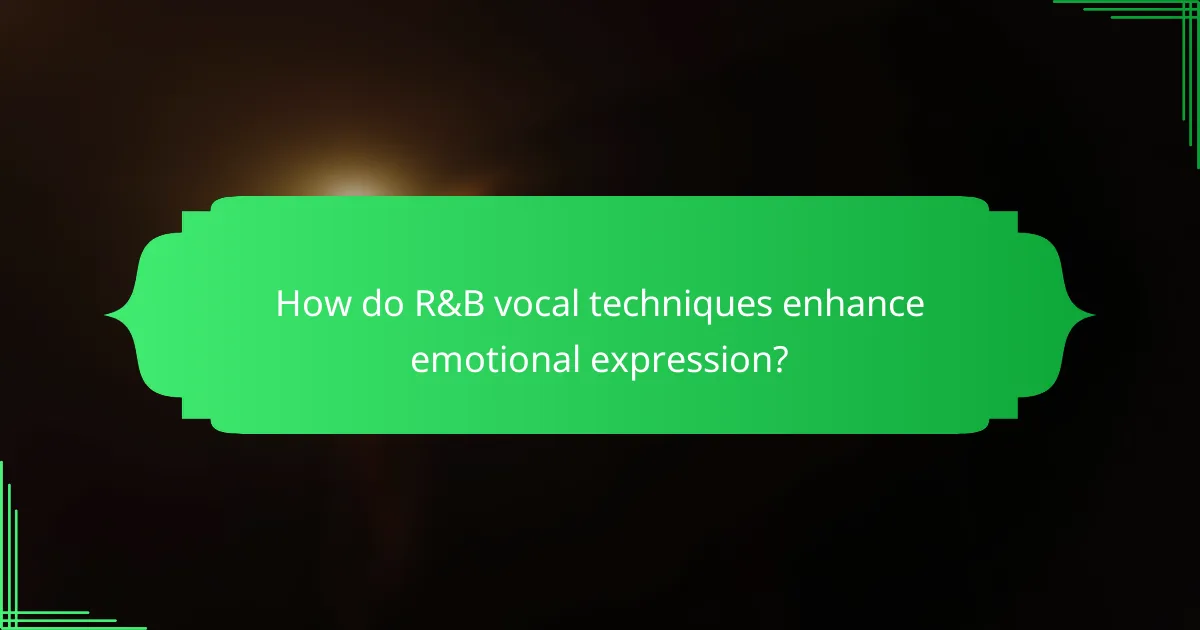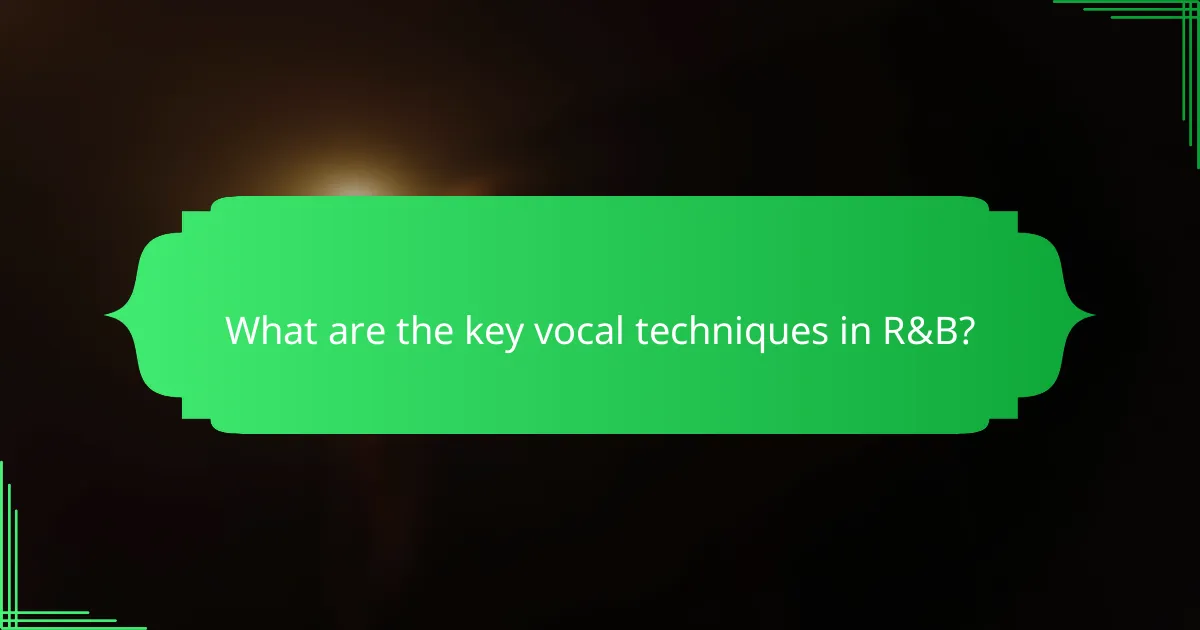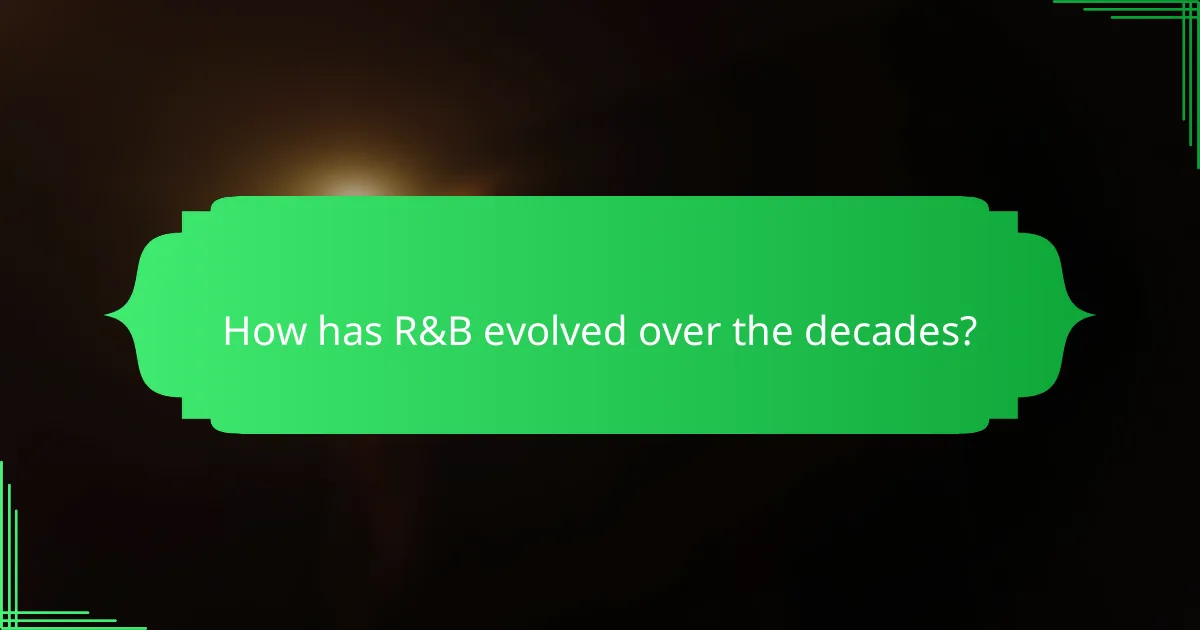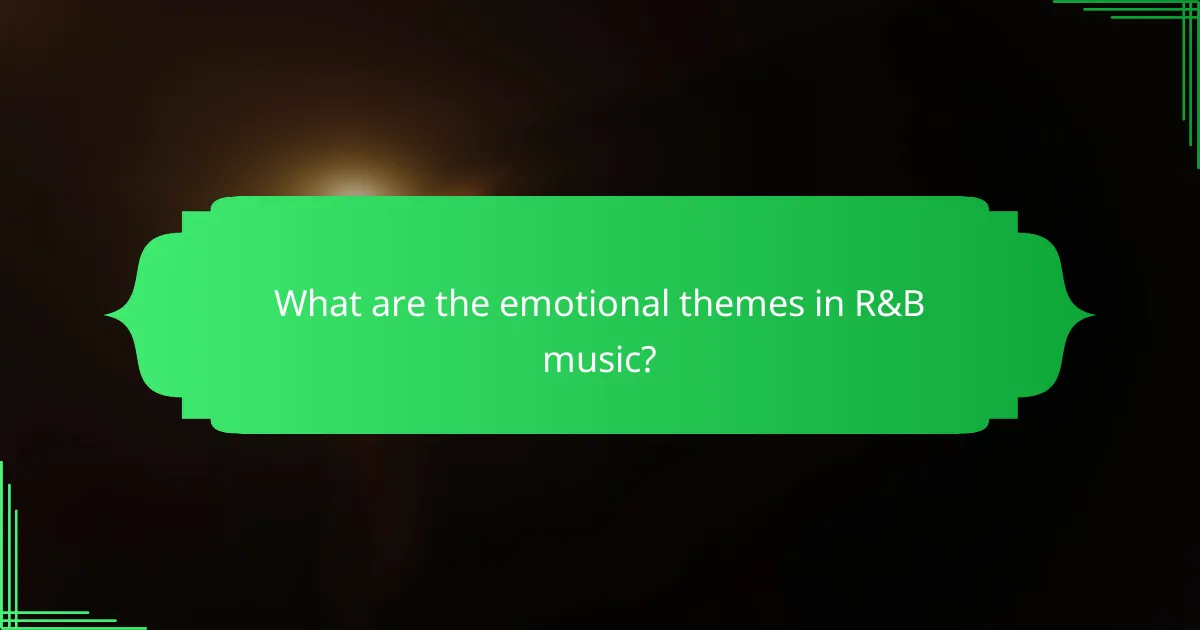R&B vocal techniques play a crucial role in enhancing emotional expression, enabling artists to convey deep feelings through their nuanced delivery. Techniques such as melisma, falsetto, and dynamic range manipulation create a rich emotional landscape that resonates with listeners. Over the decades, R&B has evolved significantly, reflecting cultural shifts and technological advancements while incorporating diverse musical influences that shape its contemporary sound.

How do R&B vocal techniques enhance emotional expression?
R&B vocal techniques significantly enhance emotional expression by allowing singers to convey feelings through nuanced delivery. Techniques such as melisma, vocal runs, and dynamic range manipulation create a rich emotional landscape that resonates with listeners.
Use of melisma
Melisma involves singing multiple notes on a single syllable, which adds depth and emotion to a performance. This technique can evoke feelings of longing or passion, making the lyrics more impactful. For instance, artists like Mariah Carey and Whitney Houston are known for their masterful use of melisma to enhance emotional delivery.
Vocal runs and riffs
Vocal runs and riffs are quick, elaborate sequences of notes that embellish melodies. These flourishes can express excitement or intensity, drawing listeners into the emotional core of a song. Practicing runs in various keys can help singers develop their agility and improve their overall vocal expression.
Dynamic range manipulation
Manipulating dynamic range involves varying volume and intensity throughout a performance. This technique can highlight emotional peaks and valleys, making the music more engaging. For example, a soft, whisper-like delivery can create intimacy, while a powerful belt can convey strength and urgency.
Breath control techniques
Effective breath control is essential for sustaining notes and executing complex vocal techniques. Singers should practice diaphragmatic breathing to improve their lung capacity and control. Techniques such as inhaling deeply before a phrase or using controlled exhalation can help maintain vocal clarity and strength.
Improvisation in performance
Improvisation allows singers to express themselves spontaneously, adding a unique flair to live performances. This can involve altering melodies or adding spontaneous vocal runs. Developing improvisational skills can enhance a singer’s ability to connect with the audience and convey genuine emotion.

What are the key vocal techniques in R&B?
Key vocal techniques in R&B include falsetto, vibrato, resonance adjustments, and belting. These methods enhance emotional expression and contribute to the genre’s distinctive sound, allowing artists to convey deep feelings and connect with their audience.
Falsetto usage
Falsetto is a vocal technique that allows singers to reach higher pitches beyond their normal range. In R&B, it is often used to create a soft, airy quality that adds emotional depth to a song. Artists like Prince and Justin Timberlake effectively utilize falsetto to evoke feelings of longing or tenderness.
To practice falsetto, focus on breath control and relaxation. Start by humming at a comfortable pitch and gradually slide up to higher notes. Avoid straining your voice, as this can lead to vocal fatigue.
Vibrato application
Vibrato involves a slight, rapid variation in pitch that adds richness and warmth to a singer’s voice. In R&B, vibrato is often employed to enhance emotional delivery and create a more engaging performance. A well-executed vibrato can make a phrase feel more dynamic and expressive.
To develop vibrato, practice sustaining a note and gently oscillating your pitch. Aim for a controlled, consistent movement rather than a wide fluctuation. Listening to R&B artists can help you identify effective vibrato techniques.
Resonance adjustments
Resonance adjustments involve modifying the shape of the vocal tract to enhance sound quality and projection. In R&B, singers often manipulate resonance to create a fuller, richer tone that resonates emotionally with listeners. This technique can help convey different moods, from sultry to powerful.
To improve resonance, experiment with vocal exercises that focus on vowel shapes and mouth positioning. Try singing with an open throat and relaxed jaw to find your optimal resonance. Recording yourself can help you identify areas for improvement.
Belting techniques
Belting is a powerful singing technique used to project the voice at higher volumes without straining. In R&B, belting is often used during climactic moments to convey strong emotions and captivate the audience. Artists like Beyoncé and Aretha Franklin are known for their impressive belting abilities.
When practicing belting, focus on breath support and proper vocal placement. Engage your diaphragm and avoid pushing from your throat to prevent damage. Start with shorter phrases and gradually increase intensity as you build confidence and strength.

How has R&B evolved over the decades?
R&B has transformed significantly since its inception, reflecting changes in culture, technology, and musical influences. From its roots in the 1940s to the contemporary sounds of today, R&B has continuously adapted, incorporating various genres and styles.
Influence of gospel music
Gospel music has played a crucial role in shaping R&B, particularly in its vocal techniques and emotional expression. The powerful, soulful singing styles found in gospel have influenced R&B artists to emphasize vocal delivery and emotional connection in their performances.
Many early R&B singers, such as Ray Charles and Aretha Franklin, drew heavily from gospel traditions, using call-and-response patterns and rich harmonies that resonate with audiences. This connection to gospel continues to be evident in the music of contemporary R&B artists.
Integration of hip-hop elements
The integration of hip-hop elements into R&B has significantly altered the genre’s sound and structure. Starting in the late 1980s and gaining momentum in the 1990s, R&B began to incorporate rap verses, beats, and production techniques, creating a hybrid style that appeals to a broader audience.
Artists like Mary J. Blige and Usher have successfully blended R&B melodies with hip-hop rhythms, leading to a new wave of music that resonates with younger listeners. This fusion has become a defining characteristic of modern R&B, making it more dynamic and versatile.
Impact of technology on production
Advancements in technology have revolutionized R&B production, allowing for greater creativity and experimentation. The rise of digital audio workstations (DAWs) and affordable recording equipment has enabled artists to produce high-quality music from home studios.
Additionally, the use of auto-tune and other vocal effects has changed how singers approach their craft, allowing for unique vocal stylings that were previously unattainable. This technological evolution has contributed to the polished sound of contemporary R&B, making it more accessible and appealing to diverse audiences.
Emergence of contemporary R&B
Contemporary R&B has emerged as a distinct genre, characterized by its blend of traditional R&B elements with influences from pop, electronic, and hip-hop music. Artists like Frank Ocean, SZA, and Khalid exemplify this modern sound, often focusing on themes of love, identity, and social issues.
This evolution has led to a more experimental approach to songwriting and production, with many contemporary R&B artists pushing the boundaries of the genre. The result is a rich tapestry of sounds and styles that continues to evolve, reflecting the changing landscape of music and culture.

What are the emotional themes in R&B music?
R&B music often explores deep emotional themes, primarily focusing on love, social issues, and personal struggles. These themes resonate with listeners, creating a powerful connection through relatable experiences and heartfelt expression.
Love and heartbreak
Love and heartbreak are central themes in R&B, capturing the complexities of romantic relationships. Artists frequently convey feelings of passion, longing, and sorrow through their lyrics and vocal delivery, making these emotions palpable for listeners.
For instance, songs may depict the joy of new love contrasted with the pain of a breakup, often using vivid imagery and personal anecdotes. This emotional rollercoaster keeps audiences engaged and reflective on their own experiences.
Social issues and empowerment
R&B also addresses social issues, including racism, inequality, and empowerment. Many artists use their platform to highlight struggles faced by marginalized communities, promoting messages of resilience and hope.
Tracks that focus on empowerment often encourage listeners to embrace their identity and fight against adversity. This thematic depth not only entertains but also inspires change and awareness within society.
Personal struggles and triumphs
Personal struggles and triumphs are frequently explored in R&B, with artists sharing their journeys through adversity. These narratives often include themes of self-discovery, mental health, and perseverance, resonating with those facing similar challenges.
By articulating their vulnerabilities and victories, R&B singers create a sense of solidarity with their audience. This connection fosters a supportive community, encouraging listeners to confront their own issues and celebrate their successes.
